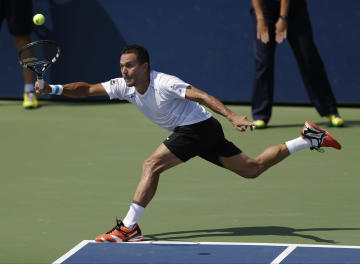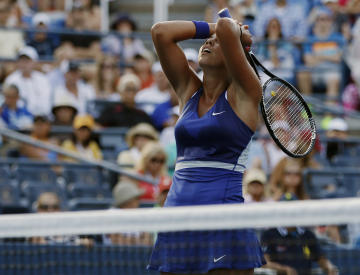At the U.S. Open, follow the noise

NEW YORK — I was walking up the ramp that leads into Arthur Ashe Stadium when I heard the first true roar of this year's U.S. Open. It was Tuesday, Day 2, and the noise came from the court directly behind me. I already knew what I'd find inside Ashe: 19th seed John Isner was working his way through Marcos Giron.
What was all the racquet behind me? I turned around, walked across the open plaza that separates Ashe from Courts 4, 5, and 6, and found a seat in the stands behind one of the Court 6 baselines. There, Victor Estrella Burgos was close to sealing a come-from-behind victory over Igor Sijsling. At 34, he is the oldest man to ever make his U.S. Open debut. He is also the first man from the Dominican Republic to play in the main draw here.

If not for the crowd, I would’ve missed the match completely. They chanted in Spanish. They chanted in English. When he closed out the 2-6, 6-4, 6-3, 6-2 win, they erupted. After a relatively quiet first day, it finally felt like we were back at the U.S. Open.
Later on Day 2, the noise called me back to Court 6. This time, I unknowingly walked into what would become the biggest upset of the first round. I didn't immediately recognize the American on the court. Neither did many of the fans, but all had her back. She was 15-year-old CiCi Bellis. With every point, the anticipation grew — finally, a major upset.
From my seat, I could also see Court 4, where Christina McHale was putting on her own solid performance. It created a ping-pong of cheers bouncing from Court 4 to 6, interrupted only by occasional applause for American Tim Smyczek, who was lucky (or unlucky, depending on how you see it) enough to be playing on Court 5, sandwiched right between McHale and Bellis's matches.
The crowds are one of the highlights of this fortnight in New York. The Americans often credit them with creating the home-field advantage they need. Novak Djokovic commented that his third round match will be more difficult because he’ll face an American, Sam Querrey, who will have the crowd behind him. After her first round match, Venus Williams said the crowd here creates amazing moments.
Sometimes the crowd is too much. In his Wednesday night match on Ashe, Stan Wawrinka turned to a fan and said, “Seriously, shut up.” He later tweeted that he thought the fan was drunk. Most of the time, though, the players embrace the atmosphere.
“It helps a lot. It really does,” Isner said after his second round win on Thursday. “Especially here. You know, this crowd is – this is arguably the most exciting tournament in the world. The fans are into it.”
Reporters here quickly learn that the fans will guide them to the best matches. It’s impossible to be on every court at once. You can pick a court and hope for the best. You can spend the day inside, staring at a screen and flipping between match feeds. Or, you can walk around, waiting for bursts of applause, letting the fans tell you where to go (and then get there, fast).
It’s natural that the crowds on the outer courts will be larger later in the tournament. By Friday, many of the marquee matches are inside Ashe, which requires a separate ticket. Long lines form early for the Grandstand and Louis Armstrong Stadium.
But this Thursday, fans sticking to the outer courts saw a recent champion fall to an unseeded player. I joined them briefly, drawn by the size of the crowd and kept there when I saw that Samantha Stosur trailed 5-0 in the second set. New Yorkers usually love an upset. Today, though, they wanted to see Stosur advance. When she rallied back to 5-3, the crowd showed its love.
It was between the second and third set that I wandered off again. I knew, from the noise, that something big was happening on Court 11. I’d later hear that CoCo Vandeweghe had lost in two sets. I wasn’t drawn to that one, though, because I was determined to get to Armstrong. There, 27tth seed Madison Keys had just forced a third set against Aleksandra Krunic, and lines were starting to form.
As I approached the stadium, I saw what looked like at least a thousand people in line. There were short lines to get into Keys’s match, but the lines I was seeing were for the Grandstand, the stadium adjacent to Armstrong. The Williams sisters were coming up next on Grandstand, about to start their quest for their third U.S. Open doubles title. It was one of those rare instances where fans arrive well before the match starts, and stay through the last point, regardless of how lopsided it turns out.

Inside Armstrong, Keys was up a break in the third set, but starting to look exhausted. The fans tried as best they could. “Steady, Madison, steady!” a man yelled during a crossover.
As Keys tried to hold on, the stadium was filled with the spillover sounds of the Grandstand crowd. It level of cheering could only mean one thing: the Williams sisters were underway next door.
Despite the crowd’s best effort to lift her up, Keys fell short. As she shook hands with Krunic at the net, I looked at a score update. Stosur, too, had fallen, losing a third set tiebreak. Two seeded players ousted in second-round upsets within minutes of each other. Two matches that I made it to because of the fans.
As I walked out of the stadium at 5:38p.m., some of the day session ticket holders were making their way to the exits. Others were keeping the volume up, cheering on Estrella-Bargos on Court 6 and Tommy Robredo on Court 17. Many at 17 came in search of the next match – CiCi Bellis was scheduled last there – but based on the sounds floating across the grounds, the crowd was getting into the Robredo match.
As Andy Murray took the court for his primetime match in Ashe, they continued to wait for Bellis. Bursts of applause rose from the Grandstand, where the Williams sisters were in the third set. There were still six matches underway. Bellis's would be the final match of the day session. And every one of the fans here hoped that they could make enough noise to propel CiCi Bellis to another victory.
More U.S. Open coverage:


